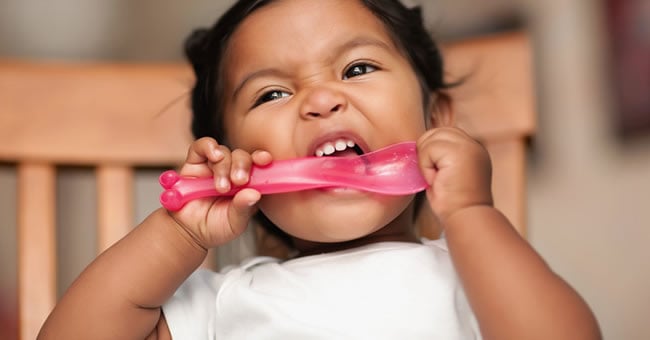
If you work with children younger than three, you know that biting is a common behavior. Biting serves a variety of purposes for infants and toddlers–it's a way to explore, a way to relieve teething pain, and a way to communicate with others. Even though biting is a part of children's growth and development, it has to be appropriately addressed in early care and education settings to ensure that no one is injured and that children learn the proper ways to handle emotion and communication. In their book Innovations: Infant & Toddler Development, Kay Albrecht and Linda G. Miller share the following information about dealing with biting in infant-toddler environments:
Types of Biting
To appropriately respond to and prevent biting, you first need to understand why children bite. There are three types of biting that are generally seen in early care and education settings:
- Investigative/Exploratory Biting – Children between early infancy and 14 or 15 months explore everything with their mouths in order to see what things taste and feel like. Biting is a part of play at this age and gives young children an opportunity to investigate and explore their environment.
- Action/Reaction Biting – Children between the ages of 9 and 29 months will become fascinated with connecting actions with reactions. They will generally bite to see what types of reactions they get from the other children and adults in the room.
- Purposeful Biting – This type of biting occurs when children are trying to get something or want to change the outcome of a situation. Purposeful biting usually starts around 18 months, but the biting should decline and stop near the child's third birthday.
Ways to Address Biting
- Prevention – One of the best prevention strategies is to create an environment that enables you to spread children throughout the available space. Environments that are broken up into "nooks and crannies" encourage children to play alone or with one or two other children, which ultimately decreases the number of biting episodes.
- Anticipation – Observation is an important part of being able to anticipate and prevent biting episodes. Take note of when, where, and with whom biting occurs to ensure that you have the information you need to limit the chances of biting occurring. Two examples of anticipation strategies are separating a biter from a frequent target and rearranging play pairs.
- Substitution – If children are teething, you can help them learn to control biting by giving them teething rings or soft rubber manipulative toys. These substitute items will soothe sore gums and help prevent children from biting others as a way to relieve the pain.
- Supervising and Shadowing Biters – Children who are frequent biters may need increased supervision. You can also shadow the child or limit his or her ability to move around the classroom by having him or her hold your hand as you move around the room for short periods of time. This strategy will help children understand that biting isn't allowed. However, if the biting persists, ask another teacher or staff member to observe the child. Someone who isn't as close to the situation may notice something you overlooked.
- Teaching Children Social Interaction Skills – Giving young children the social interaction skills they need will also help them control their biting. The first social interaction skill young children need to learn is delayed gratification since most of the conflict for this age group occurs when there are limited resources (e.g., toys, crayons, the teacher's lap). Once children are able to wait for a moment, you can start teaching children to use their words instead of biting. Taking turns and sharing are the next skills children need to learn. You should see a decrease in biting episodes as children master these social interaction skills.
Points to Remember
- All children bite occasionally as they grow and develop, but don't let children bite without getting a negative reaction from you.
- Make sure you comfort children who are bitten. Give them a hug, offer them an ice pack, or let them hold a stuffed animal until they are calm.
- Write a written report of all biting incidents. You should also talk with parents about any concerns you may have about children's behaviors.
- Remember that biting rarely causes any health problems, but you should make sure you have a plan for handling any biting incident that occurs.
Talking with Parents About Biting
Parents will likely be upset when their child is bitten by another child–they may even accuse you of failing to protect their child from harm. Work to reassure parents that biting is a natural part of children's development and that it is a stage all children go through. Have a plan to address any biting episodes that occur and share it with parents. Be calm and professional when talking with parents about biting, and emphasize that children will stop biting as they mature and as you implement your plan.
Check out our selection of resource books for more information about biting, child development, and classroom management.
Article Source
Albrecht, Kay, and Linda G. Miller. Innovations: Infant & Toddler Development. Beltsville, MD: Gryphon House, Inc., 2001.
